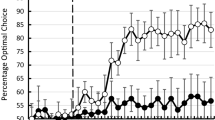Abstract
The effects of pimozide (0.06, 0.18, 0.30 mg/kg), a dopamine receptor blocker, on nondiscriminated and discriminated performance were assessed in pigeons using a Latin Square design. In Experiment 1 a dose-dependent decrease in responding was observed with a variable interval 3-min schedule of reinforcement. More detailed analyses showed that total response rate, running respose rate, and post-reinforcement pause all showed the same dosedependent relationship. In Experiment 2 a successive discrimination task was employed to determine if pimozide affects a previously learned association between environmental stimuli. Each pigeon was first trained on the discrimination and then injected with the same doses as in Experiment 1. Although pimozide reduced responding in a dose-related fashion, a corresponding decrease in accuracy of responding was not evident. It was concluded that pimozide has a general response debilitating effect and that dopaminergic neurons probably are not involved in subserving associative processes.
Similar content being viewed by others
References
Ahlenius S, Engel J (1976) Normalization by anti-psychotic drugs or biochemically induced abnormal behavior in rats. Psychopharmacology 49:63–68
Ahlenius S, Engel J, Zoller M (1977) Effects of apomorphine and haloperidol on exploratory behavior and latent learning in mice. Physiol Psychol 5:290–294
Anden NE, Butcher SG, Corrodi H, Fuxe K, Ungerstedt U (1970) Receptor activity and turnover of dopamine and noradrenaline after neuroleptics. Eur J Pharmacol 11:303–314
Beninger RJ, Mason ST, Phillips AG, Fibiger HC (1980a) Use of conditioned suppression to evaluate the nature of neurolepticinduced avoidance deficits. J Pharmacol Exp Ther 213:623–627
Beninger RJ, Mason ST, Phillips AG, Fibiger HC (1980b) Use of extinction to investigate the nature of neuroleptic-induced avoidance deficits. Psychopharmacology 69:11–18
Fibiger HC (1978) Drugs and reinforcement mechanisms: A critical review of the catecholamine theory. Ann Rev Pharmacol 18:37–56
Fibiger HC, Zis AP, Phillips AG (1975) Haloperidol-induced disruption of conditioned avoidance responding: Attenuation by prior training or by anticholinergic drugs. Eur J Pharmacol 30:309–314
Fouriezos G, Wise RA (1976) Pimozide-induced extinction of intracranial self-stimulation: Response patterns rule out motor or performance deficits. Brain Res 103:377–380
Franklin KBJ, McCoy SN (1979) Pimozide-induced extinction in rats: Stimulus control of responding rules out motor deficit. Pharmacol Biochem Behav 11:71–75
Hulse SH, Fowler H, Honig WK (1978) Cognitive processes in animal behaviour. Lawrence Erlbaum, Hillsdale NJ
Hunt HF (1956) Some effects of drugs on classical (Type S) conditioning. Ann NY Acad Sci USA 65:258–267
Kirk RE (1968) Experimental desingn: Procedures for the behavioral sciences. Betriont, Wadsworth CA
Phillips AG, Fibiger HC (1979) Decreased resistance to extinction after haloperidol: Implications for the role of dopamine in reinforcement. Pharmacol Biochem Behav 10:751–760
Posluns D (1962) An analysis of chlorpromazine-induced suppression of the avoidance response. Psychopharmacologia 3:361–373
Ranje C, Ungerstedt U (1977) Discriminative and motor performance in rats after interference with dopamine neurotransmission with spiroperidol. Eur J Pharmacol 43:39–46
Thompson DM (1978) Stimulus control and drug effects. In: Blackman DE, Sanger DJ (eds) Contemporary research in behavioral pharmacology. Plenum Press, New York
Tombaugh TN, Anisman H, Tombaugh J (1980) Extinction and dopamine receptor blockade after intermittent reinforcement training: Failure to observe functional equivalence. Psychopharmacology 70:19–28
Tombaugh TN, Tombaugh J, Anisman H (1979) Effects of dopamine receptor blockade on alimentary behaviors: Home cage food consumption, magazine training, operant acquisition and performance. Psychopharmacology 66:219–226
Wise RA (1978) Catecholamine theories of reward: A critical review. Brain Res 152:215–247
Wise RA, Spindler J, DeWit H, Gerber G (1978a) Neuroleptic-induced “anhedonia” in rats: Pimozide blocks the reward quality of food. Science 201:262–264
Wise RA, Spindler J, Legault L (1978b) Major attenuation of food reward with performance-sparing doses of pimozide in the rat. Can J Psychol 132:77–85
Yokel RA, Wise RA (1975) Increased lever pressing for amphetamine after pimozide in rats: Implications for a dopamine theory of reward. Science 187:547–549
Yokel RA, Wise RA (1976) Attenuation of intravenous amphetamine reinforcement by central dopamine blockade in rats. Psychopharmacology 48:311–318
Author information
Authors and Affiliations
Rights and permissions
About this article
Cite this article
Tombaugh, T.N. Effects of pimozide on nondiscriminated and discriminated performance in the pigeon. Psychopharmacology 73, 137–141 (1981). https://doi.org/10.1007/BF00429204
Received:
Accepted:
Issue Date:
DOI: https://doi.org/10.1007/BF00429204




